Car-Owning Households up by 355,000 in the GTHA, 88,000 in the City of Toronto, and 26,000 in the Toronto Core since 2006
By: Dr. Frank Clayton
December 13, 2018
Background
Transit investment in the Greater Toronto and Hamilton Area (GTHA) is only keeping pace with population growth, and is not significant enough to result in large-scale shifts in travel behaviour.
Transportation policies have focused on increasing the viability and the use of non-automobile travel in recent years. The 2006 Growth Plan for the Greater Golden Horseshoe (the Growth Plan) sought to “[reduce] dependence on the automobile through the development of mixed-use, transit-supportive, pedestrian-friendly urban environments.”1 The 2017 update of the Growth Plan reiterated the same idea. Likewise, municipal policy documents such as Toronto’s Official Plan aimed to “increase opportunities for walking, cycling, and transit use and support the goal of reducing car dependency throughout the City.”2
Despite these efforts, the results of the Transportation Tomorrow Survey (TTS), a household survey conducted every five years on regional travel behavior, showed that the ratio of car ownership in the GTHA has seen little change as the total number of vehicles has skyrocketed with population growth.3
Here are some of the key highlights from the survey. (Note that the City of Toronto is referred to as “Toronto” in the text.)4
GTHA Highlights
1986-2016
• The number of car-owning households in the GTHA increased sharply from 1.3 million in 1986 to 2.3 million in 2016.5 The largest area of growth occurred outside of Toronto, but Toronto itself also saw an increase of 164,000 car-owning households. (See Figures 1a and 2a).
• The percentage of households without a car in the GTHA increased from 15% to 16% only between 1986 and 2016. (See Figures 1a). The increase from 21% to 28% in Toronto itself was offset by the decline in these households in the rest of the GTHA. (See Figures 1a and 2a).
2006-2016
• The number of car-owning households in the region has increased steadily both before and after 2006. (See Figure 1a).
• Since 2006, the percentage of households without cars has remained at 16% in the GTHA, and has increased only slightly in Toronto. (See Figures 1a and 2a).
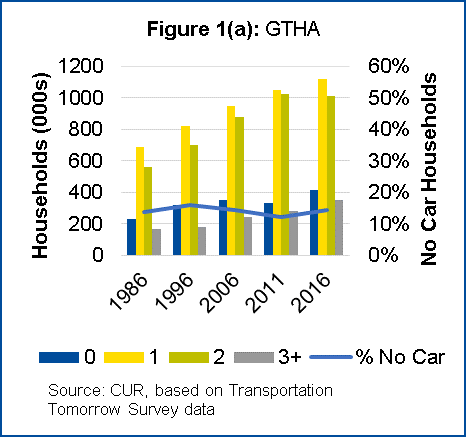
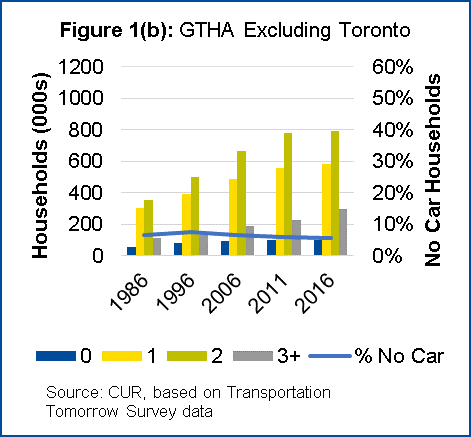
City of Toronto Highlights
1986-2016
• Since 1986, the number of households with cars rose in all three sub-areas of Toronto. In the Toronto Core, the number of households with cars increased from 34,000 in 1986 to 76,000 in 2016. (See Figure 2b).
• The highest proportion of car-less households is in the Toronto Core at 51%, a number only marginally higher than in 1986. (See Figure 2b).
• The percentage of car-less households increased modestly in the areas of Toronto beyond the Toronto Core (see Figure 2c), with increases higher in the old city than in the postwar suburbs. (See Figure 2d).
2006-2016
• The proportion of households without cars remained almost the same between 2006 and 2016 except in Old Toronto outside of the Toronto Core, (see Figure 2c), where it increased from 32% to 37%. (See Figure 2d).
• In Old Toronto, the number of households with two and three cars has shrunk. (See Figure 2d).
• The number of cars in Toronto’s postwar suburbs has grown with population, while the proportion of households with multiple cars has remained stable. (See Figure 2d).
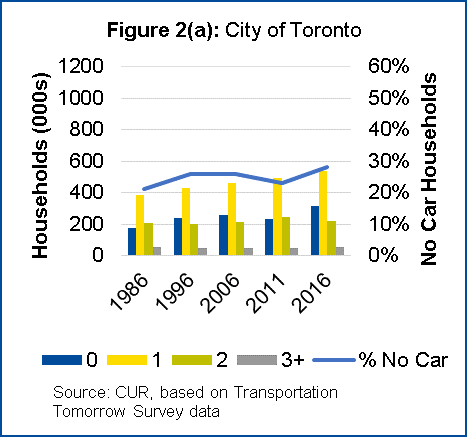
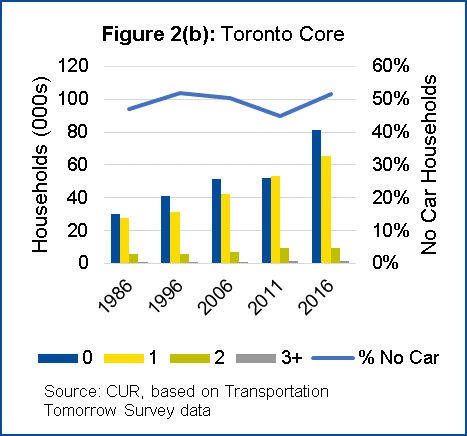
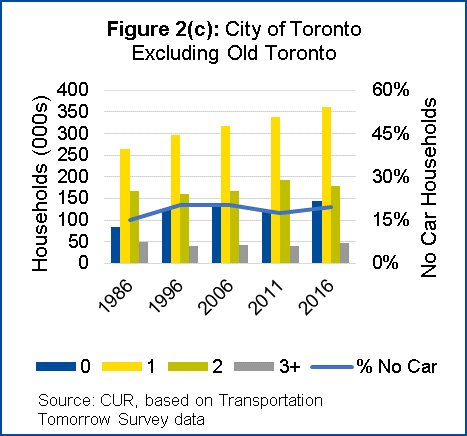
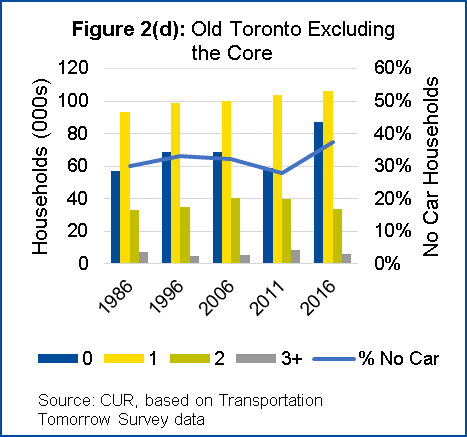
The Future
Short of an autonomous vehicle disruption or greatly increased transit investment, the number of private cars will continue to grow for the foreseeable future and road congestion will increase accordingly. Metrolinx’s 2041 Regional Transportation Plan predicted that even with the recommended investment, the transit mode share would only increase by 0.5 percentage points between 2011 and 2041 in the GTHA during peak morning hours.6 This means that the number of trips by car will increase by 4.4 million daily trips during the peak rush hour by 2041 compared to 2011.
_______________________________________________________________________
(1) Ministry of Municipal Affairs. (2006). Growth Plan for the Greater Golden Horseshoe. http://placestogrow.ca/images/pdfs/ggh2017/en/growth%20plan%20%282017%29.pdf
(2) City of Toronto. (2015). City of Toronto Official Plan. https://www.toronto.ca/city-government (external link) /planning-development/official-plan-guidelines/official-plan/
(3) Data was sourced from TTS 2016: 2016, 2011, 2006, 1996 and 1986 Travel Summaries for the Greater Toronto & Hamilton Area, (2018). http://dmg.utoronto.ca/pdf/tts/2016/2016TTS_Summaries (external link) _GTHA.pdf Numbers of households for each rate of car ownership were calculated based on the percentage of households by car ownership and the total number of households published in the report. Since the percentages in the report did not always sum to 100% as a result of rounding, values in this post are accurate +/- 1%.
(4) For the purposes of this post, the GTHA is split between the City of Toronto and the rest of the GTHA, City of Toronto is split between the Core, the old city of Toronto, and the rest of the city. The “Toronto Core” was defined as Planning District 1 as found in the Transportation Tomorrow Survey. This definition included the area bound by the CP rail line to the north, the Don Valley to the east, Lake Ontario to the south, and Bathurst Street to the west. Some areas south of Queen Street between Dufferin Street and Woodbine Avenue were also included. Old Toronto refers to the City of Toronto pre-1988 amalgamation.
(5) “Car” in this post is used in place of “vehicle” in the Transportation Tomorrow Survey.
(6) Metrolinx. (2018). 2041 Regional Transportation Plan for the Greater Toronto and Hamilton Area. (PDF file) http://www.metrolinx.com/en/docs/pdf/board_agenda/20180308/20180308_BoardMtg_Draft_Final_2041_RTP_EN.pdf (external link)
Frank Clayton, PhD, is the Senior Research Fellow at Toronto Metropolitan University’s Centre for Urban Research and Land Development (CUR) in Toronto.
Research assistance for this blog was provided by Tyler Olsen, MPI and Alex Butler, BA.
_________________________________________________________________________________________________________